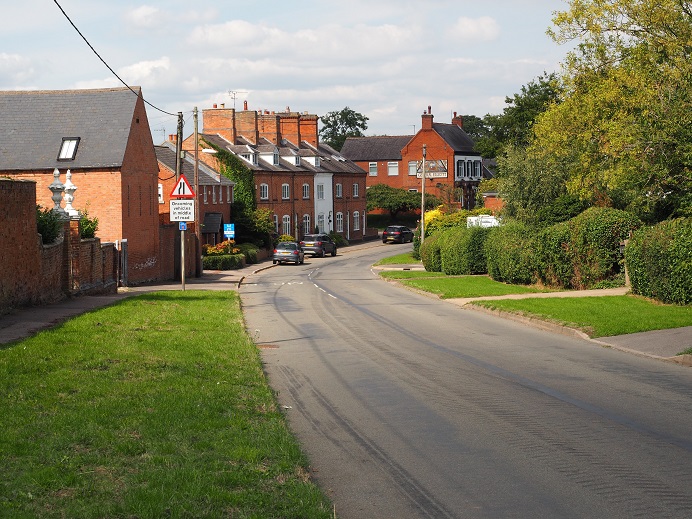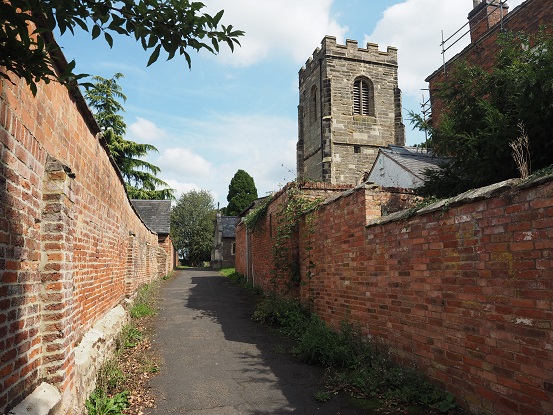Willoughby
Waterleys
Leicestershire
 | This
small village and civil parish in Leicestershire is about 9 miles south
of Leicester near to the A426
Leicester-Lutterworth road and about a mile from the M1 motorway
between Junctions 20 and 21. Grid Reference is SP5792. The
population
in the 1911 Census was 207 and in the 1921 Census 210.
Until fairly recent times, the village was known as
Willoughby Waterless. Its antiquity is beyond doubt as it is
mentioned in Domesday Book. The village houses lie mostly on
either side of Main Street, which runs from North to South.
There
is a wide mix of building types and styles, the oldest including
cottages, houses and farms dating from the mid-17th Century to rather
grand
Victorian homes, smaller terraced buildings and
a few more recent housing developments. The 2011 Census gave a
population
of 327, with the main male occupations (about 75%) described
as
Managers, Directors, Senior officials, Professional Occupations and
Skilled Trade Occupations. The main female occupation
category in
2011 was Secretarial and Administrative Work. As the village is
surrounded by farmland (incidentally, there are still a few farms in the village
itself) the majority of residents can be assumed to work away
from the village and certainly, during our visit, Main Street was very
quiet. (In the 1851 Census, the highest proportion of
males over 21 years - more than half - worked in Agriculture).
The Village has a pub, The "General
Elliott" -
named after the General
of that name who defended Gibraltar against the
Spaniards in
the Great Siege 1779-83.
There is also a fine 1846 National School building, now used as a Village Hall. |

The
Parish Church of St. Mary is rather hidden away from passers-by, and is
reached via a little passageway. The building dates largely
from the 13th Century but is believed to have retained its original
Norman tower and it also has a small, very well-kept churchyard
with several graves
still clean and legible after 200 years.
There is no war memorial
in the village, but there is a plaque on the Altar in the Parish Church
referring to some carved oak figures in the
reredos. This
plaque says the Carved Oak Figures "Were Given
in Thank Offering
for 'Victory of Peace' and were dedicated by
the Rev. J. Kerry Williams at
Harvest Eucharist September 28 1919.
JLH Jenkyn, Rector."
We found three "Soldiers
Died" whose records
associate them with Willoughby Waterless.
We have been able to determine that none of them lived
in this village. For each one of them, the association
with the village comes from the address given
by the relative when
completing the Final Verification Form some
time after the war. Sgt.
P. Chester's wife remarried and was living with
her new husband in Willoughby Waterleys when
she completed the form. Pte Bertie Daverage
lived with his
family in Leicester and worked in the shoe
industry. His
mother moved to Willoughby Waterleys after the war, by then a
widow in her 60s, possibly looking
for domestic service.
The
previous two men served in the Leicestershire Regiment. The final
soldier, Ernest Ingham, served as a Private in the King's
Liverpool Regiment.
He died on 1 July 1916, has no known grave, and
is named on the Thiepval Memorial to the Missing of the Somme, France.
His Commonwealth War Graves Commission register entry names him as "Son
of the Rev. Ernest Ingham of Willoughby Waterleys Rectory,
Leicester". In the 1911 Census, the family were
shown as living in Liverpool; the father, also Ernest
Ingham, was described as "Clerke in Holy
Orders". This
led us to ask to look at the list of
Vicars/Rectors of this church. In
this list, John L.H. Jenkyn (mentioned on the
1919 plaque) was Vicar/Rector 1904 to 1922; Ernest A.
Ingham was Vicar 1922 to 1940.
So his son, who died in 1916, could never have lived
in Willoughby Waterleys. This
is
where the father was living when he completed the Final
Verification Form.
But
there were Willoughby Waterleys men who served. We have found the
service
records of two soldiers who gave Willoughby Waterless as their place of
residence when they enlisted and again on demobilisation at the end of
the war. There may be others but it is impossible to carry
out a
full check as not all servicemen's records exist today. With
this
evidence of residence, and with no evidence that any residents died in
the war, we conclude that Willoughby Waterleys has a sound claim for
inclusion in our list of Thankful Villages.
(Thanks are due to Mike Oates, who brought Willoughby Waterleys to our
attention and carried out local research for us.)
Photos - Tom Morgan
Click
here
to return to the main Thankful Village listing

